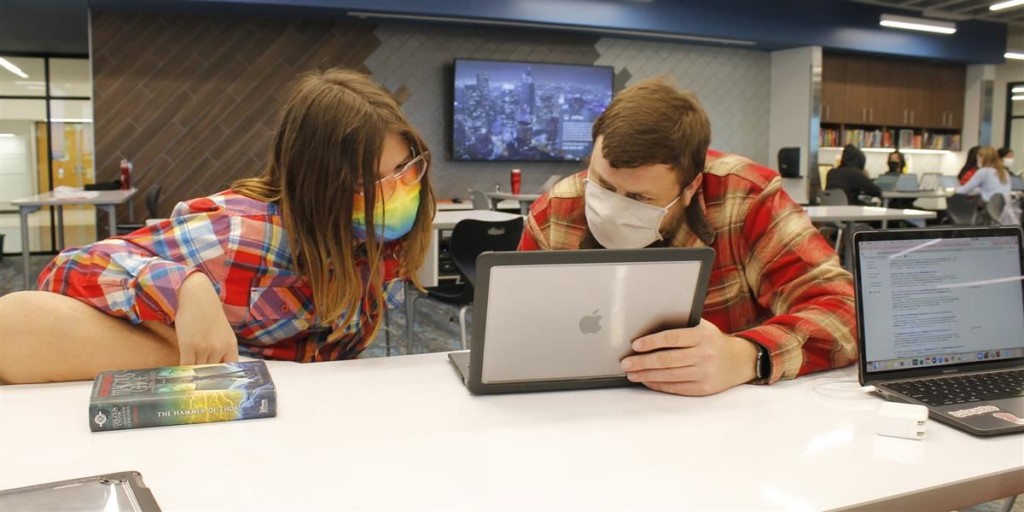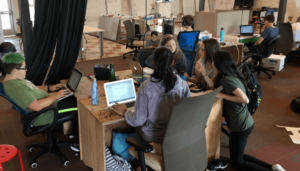Amplifying Student Voice to Design the Vision for Learning
Key Points
-
Amplifying student voices to continuously understand how learners experience their new vision of school is a priority for the EDGE team.
-
EDGE utilized a variety of strategies, including circle discussions, village meetings, and conferring, to continuously understand how our learners were feeling and performing within the EDGE learning model.

By: Dr. Sara Wickham
The scope of emotions, ranging from hope and excitement to fear and anxiety, that we must embrace on the journey of educational innovation is vast. The EDGE microschool, a globally-focused and project-based learning environment for learners in grades 9-12, opened to students in the fall of 2021. Our team of educators prepared for nearly two years to refine our vision, processes, and practices. The true test was upon us; how would our learners embrace this vision and model of learning?
As you begin anything new, the challenges can feel overwhelming and even paralyzing. We were creating, iterating, and refining at rapid speed. Our students, however, were sharing that learning feels purposeful, relevant, motivating, and challenging, in ways they had not experienced before!
Within the first month of school, Andrew, an EDGE senior, shared, “Intrinsic motivation is back. I haven’t felt this motivated about school since fifth grade.”
Amplifying student voices to continuously understand how our learners were experiencing this new vision of school is a priority for our team. As a staff team, we utilized a variety of strategies, including circle discussions, village meetings, and conferring, to continuously understand how our learners were feeling and performing within the EDGE learning model, and how this was aligning with our fulfillment of the vision.
Through circle discussions, students unpack a variety of topics, including their worries, goals, and successes. These conversations provide a safe and authentic avenue to understand the needs of our learners, and build connections among staff and students in the learning community.
Village meetings, where every EDGE teacher meets with a small group of students on a weekly basis, provide a space to build community, develop traditions, celebrate successes, and explore concerns. This environment provides a space for students to generate ideas to take ownership of the learning environment, and allows the adults to truly become the supporters of student leadership.
Within the first month of school, Andrew, an EDGE senior, shared, ‘Intrinsic motivation is back. ‘”
Dr. Sara Wickham
EDGE teachers also schedule conferring conversations with students throughout the semester. These conferring conversations provide an opportunity for students to exchange ideas and feedback about project development, progress on competencies, and learning evidence. Conversations are rich as students take ownership in how to demonstrate learning progress.
These three strategies provide authentic opportunities for students to have voice and power in shaping our learning ecosystem. As a staff, we were able to share feedback and themes that emerge from these conversations. In some situations, we are able to make adjustments the next day or week, based upon learner suggestions. In other areas, student feedback has informed our long-term goals.
While the challenges of launching a microschool are abundant, Kora, an EDGE senior, reminded us of the power of this learning model when she explained in a college application essay:
“In the school year of 2021-2022, the global microschool EDGE was founded in my district and I happily jumped on board. What I found was a new approach to education that allowed me to expand my expertise while preparing me to face the world. Grades were replaced by competencies which aimed to develop my skills as a learner rather than suppress it and projects were made with freedom and development in mind which allowed me to remain passionate about my schoolwork. I was suddenly motivated, excited even, to pursue my education and to reach a higher level. Instead of “studying” to reach an A, I engaged in school purely to learn; to grow as a person and become a true scholar. My love of learning returned and I found myself buying books again, but this time they were on the topics of history, economics, and modernization rather than the fantasy I enjoyed as a child. This was learning for me, and should be for all students.”
As we continue in our first year of EDGE, we are learning at an incredible rate, and working hard to further define our vision as we become more knowledgeable and experienced with this model of learning.
For example, a key element of learning in EDGE is a focus on mastery and competency-based learning. As we navigate implementing competency-based learning at the high school level in a traditional grading system, there are a variety of complexities.
One success has been the student ownership in the progression of learning and the ideas that students generate to show transfer of learning using real-world problems across disciplines. As a staff team, and with student input, we created a common language to describe the progression of learning:
Beginning
An indicator of BEGINNING means the student has been introduced to the skill and is learning the foundational concepts. Learning in the beginning stage is often mostly teacher-directed and teacher-supported.
Approaching
An indicator of APPROACHING means the student is practicing the skill and is close to showing independent application but may still make errors or have misconceptions. The student still requires teacher instruction and scaffolding in order to execute the skill.
Demonstrating
An indicator of DEMONSTRATING means the student is showing command of the skill and is able to execute the skill independently and with little error.
Transferring
An indicator of TRANSFERRING means the student is showing command of the skill and is able to execute the skill independently in new scenarios.
We will continue to articulate and refine our vision, so that we continue to improve and create synergy for our learners that allows them to be agents of their learning. After experiencing a semester of competency-based learning and evaluating the needs of our learners, we’ve reflected on our aspirations and will continue striving to improve in these areas.
As we create an environment of learning mastery, we collectively aspire to the following…
| 1. Learners know and understand the skills and knowledge they are expected to demonstrate. |
| 2. Learner conversations about learning are centered on skills, learning evidence, and mastery, rather than assignments, points, and grades. |
| 3. Learners understand the progression of skills/knowledge to get to the transferring level of learning. |
| 4. Learners can explain the skills and knowledge they are practicing/demonstrating with all learning and project activities. |
| 5. Learners have voice and choice in how and when they demonstrate learning, when progress is being made. |
| 6. Learners have multiple opportunities to practice and show learning evidence until they reach the demonstrating or transferring level. |
| 7. Learners have frequent opportunities to practice and demonstrate transfer of learning across disciplines. |
| 8. Learners have frequent opportunities to receive and act on feedback from their teacher, peers, and authentic audiences. |
| 9. Learners and stakeholders, including parents, teachers, counselors, & admin, clearly understand real-time progress on mastery of skills and knowledge. |
| 10. Learners understand how their learning will be reported as a grade. |
Our students will continue to be our guide as we strive for a shared vision of learning that leverages student ownership.
Dr. Sara Wickham is the Assistant Principal at Liberty High School. Follow her on Twitter at @sara_wickham.



0 Comments
Leave a Comment
Your email address will not be published. All fields are required.